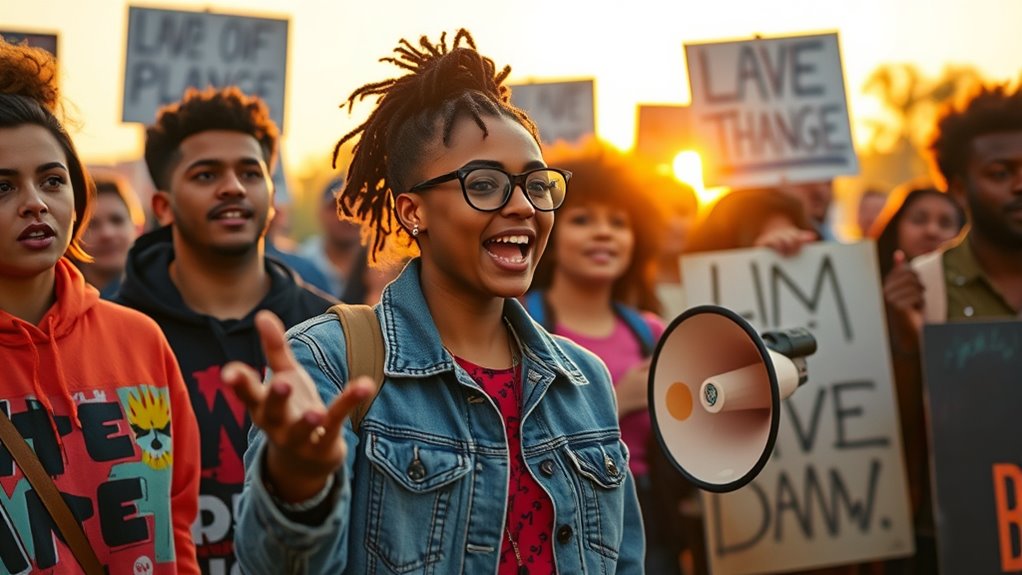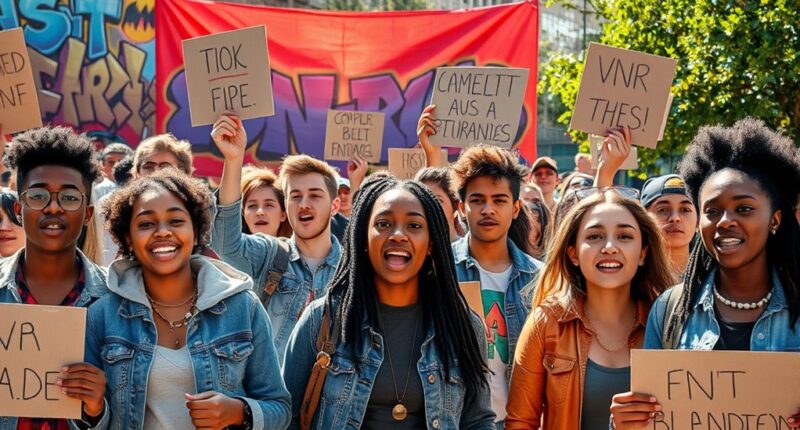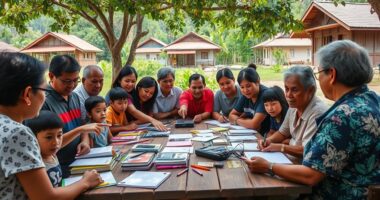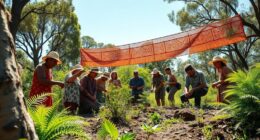Youth language warriors are young people leading powerful revival movements that reshape how society communicates. They constantly innovate with slang, digital expressions, and memes, creating a shared identity and cultural pulse. Their influence spreads rapidly through social media, influencing shifts in mainstream language and trends. By pushing boundaries and experimenting with new ways to express themselves, they are transforming communication’s future. To discover how these young change-makers are molding society, keep exploring what drives their creative linguistic revolution.
Key Takeaways
- Youth act as active creators and innovators, shaping new linguistic trends and digital dialects that influence mainstream communication.
- They use social media and viral content to rapidly spread slang, memes, and expressions, fueling language revival movements.
- Youth language serves as a cultural code, fostering identity, belonging, and community among young people.
- Young language warriors challenge traditional norms, pushing boundaries and redefining societal norms through linguistic experimentation.
- Their ongoing linguistic innovation influences sectors like marketing, education, and popular culture, driving societal language evolution.

Have you ever wondered how young people shape the way we communicate today? It’s a fascinating process, especially when you consider how teen slang and digital dialects evolve so rapidly. As a young person, or even just an observer, you might notice how the language used online and in everyday conversations reflects a desire to connect, stand out, and stay current. Teen slang isn’t just about trendy words; it’s a cultural code that signals belonging and identity among youth. Words like “bet,” “slaps,” or “no cap” have quickly moved from casual chatter to mainstream usage, illustrating how youth-driven language influences broader communication. These slang terms often spread through social media, messaging apps, and even music, creating a shared vernacular that’s constantly shifting. Digital dialects, in particular, serve as a kind of linguistic playground where young people experiment with new expressions, abbreviations, and emojis to streamline communication. Acronyms like “LOL” or “ICYMI” have become universal, yet their origins are rooted in youth communities trying to make conversations faster and more expressive. This digital language isn’t static; it evolves with trends, memes, and cultural moments, giving youth a sense of ownership over their communication styles. As a young person, you’re likely aware of how these trends start small—maybe a viral tweet or a TikTok video—and then spread rapidly across platforms, influencing even older generations. That’s the power of youth language warriors: they’re not just consumers of language but active creators, shaping the way society talks. They push boundaries, challenge traditional norms, and craft new ways to express emotion, humor, and identity. This movement isn’t limited to casual chats; it influences marketing, advertising, and even educational content, making youth language a powerful cultural force. Interestingly, the rapid spread of these new expressions is often facilitated by the rise of mobile apps that enable instant communication and sharing. What’s remarkable is how these young innovators maintain their linguistic agility, often blending slang with formal language or creating hybrid dialects that reflect their diverse backgrounds. They’re not just following trends; they’re setting them, turning their everyday slang and digital dialects into a form of cultural capital. Ultimately, you see how essential youth language warriors are because they’re shaping the future of communication. Their ability to adapt, innovate, and influence demonstrates that language isn’t static—it’s alive, constantly molded by those who use it most passionately. So, next time you hear a new slang term or see a fresh digital expression, remember it’s likely a product of young minds leading a revival movement, redefining the way we all connect.
Frequently Asked Questions
How Do Youth Language Warriors Choose Their Causes?
You choose your causes by feeling a strong connection to your cultural identity and recognizing the importance of language preservation. You might notice how your community’s language is fading or how cultural expressions are at risk. This drives you to act, whether through campaigns, workshops, or social media. Your passion for keeping your heritage alive motivates you to lead revival movements that inspire others to value and protect their linguistic roots.
What Challenges Do Young Activists Face in These Movements?
You face challenges like overcoming generational gaps, which can cause misunderstandings with older groups. Peer influence also plays a big role, sometimes pushing you toward popular causes that might not align with your true passions. Balancing respect for different perspectives while staying true to your beliefs can be tough. Despite these hurdles, your resilience and ability to connect with others keep you motivated to make a meaningful impact.
How Do Youth-Led Revival Movements Impact Their Communities?
You see, youth-led revival movements often strengthen cultural identity and boost social cohesion in your community. By actively engaging young people, they inspire pride and unity, making traditions relevant and essential. This collective effort encourages other generations to participate, creating a ripple effect that revitalizes culture. Your involvement fosters a sense of belonging, empowering your community to face challenges with resilience and shared purpose, ultimately shaping a more vibrant and cohesive society.
What Skills Are Essential for Young People Leading These Initiatives?
You need strong communication skills to inspire and organize your community effectively. Cultural awareness helps you connect authentically and respect diverse perspectives, making your initiatives more impactful. Being adaptable, empathetic, and confident also plays a crucial role in leading revival movements. By honing these skills, you can motivate others, foster unity, and drive meaningful change, ensuring your efforts resonate and create lasting positive effects in your community.
How Can Adults Support Youth Language Revival Efforts?
Imagine a bridge connecting generations, allowing vibrant words to flow freely. As an adult, you can support youth language revival by fostering intergenerational communication and showing genuine respect for their cultural expressions. Encourage conversations that celebrate their language, listen actively, and share your own stories. Your openness helps preserve cultural heritage, empowering young leaders to innovate while honoring tradition, creating a dynamic tapestry of shared cultural pride and understanding.
Conclusion
As you step into the world as a Youth Language Warrior, remember you’re the spark igniting change. Your words have the power to transform, to challenge, to unite. Like a river carving valleys over time, your voice shapes the future. Embrace this role with passion and purpose—because, in the grand tapestry of society, your voice is the vibrant thread that can weave a brighter tomorrow. Keep speaking up; your revolution begins now.









